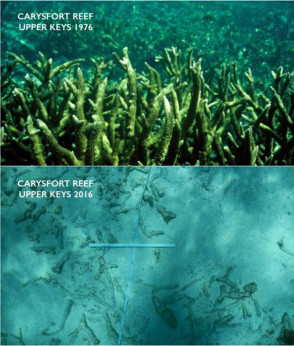Ocean Acidification Obliterates Carysfort Reef!
Greetings! In this blog, I’d like to talk about the increasing evidence of ocean acidification. In particular, research done by author and biological oceanographer from the University of Florida, Chris Langdon. This study is one of the first ones done showing the long-term effects of ocean acidification and how it affects the foundation of reefs. Mr. Langdon said, “This is what I would call a leading indicator; it’s telling us about something happening early on before it’s a crisis. By the time you observe the corals actually crumbling, disappearing, things have pretty much gone to hell by that point.”
Carysfort Reef is located in the upper part of the Florida Keys, just northeast of Key Largo. According to Langdon’s research, which was published in the journal of Global Biogeochemical Cycles, this northern part of the Florida Keys reef “has lost about 12 pounds per square yard (6.5 kilograms per square meter) of limestone over the past 6 years. Langdon said, “Over the length of the reef, that’s more than 6 million tons. The water eats away at the nooks and crannies of the limestone foundation, making them more porous and weaker.”
Langdon continued and said, “So far the effect is subtle, not noticeable to the eye, and can only be detected by intricate chemical tests. But as ocean acidification increases, scientists expect more reefs to dissolve and become flatter, and the fish will leave. Also, increasing acidity eats away at the shells of the shellfish, making them easier prey for other fish and harder for humans to harvest.”
In some of my previous blogs, I explained that ocean acidification occurs when the oceans keep absorbing high levels of carbon dioxide [CO2] in the air. This can drastically affect the seawater and create carbonic acid. Langdon said, “Acidification occurs when oceans absorb more carbon dioxide from the air, altering seawater chemistry. Scientists expected limestone to dissolve, but not until the second half of this century. It’s about 40 years early.”
Mr. Mark Eakin from the National Oceanic and Atmospheric Administration reef watch coordinator said, “This is another one of those cases where we’re finding that we’ve underestimated the level of damage caused by excess carbon dioxide in the atmosphere.”
As more updates on ocean acidification come across the wires, I’ll be sure to blog about it!
If you see any sick or injured manatees, please call the Florida Fish and Wildlife Conservation Commission at: 1-888-404-FWCC. They are the folks who are responsible for rescuing us in Florida.
Here’s the Save the Manatee Club link to learn more about us manatees …
Here’s a cool link for you to learn more about how we’re rescued and brought into rehabilitation …
~ Kobee Manatee
Related Posts
Ground Breaking Study Uncovers Fish Getting “Drunk” from High CO2 Levels! (March 30, 2016)
Could Super Coral Save Coral Reefs from Climate Change? (February 19, 2016)
“Seagrass Can Store Carbon for Centuries – Millennia” – Dr. Oscar Serrano (February 4, 2016)
UNESCO – Its Paramount Role in Ocean Acidification Awareness (January 8, 2016)
Catastrophic Effects of Increasing Ocean Acidification (December 18, 2015)
